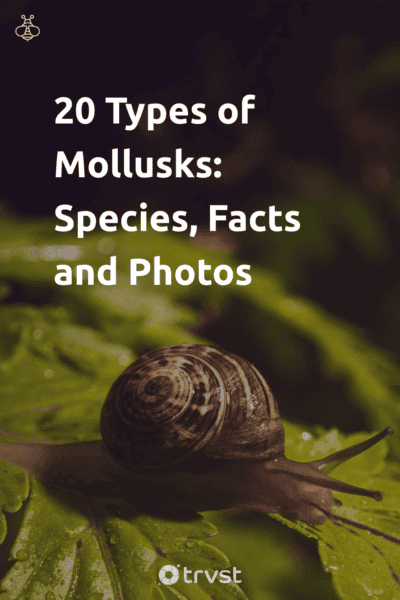20 Types of Mollusks: Species, Facts and Photos
Discover the varied types of mollusks and their ecological roles in this article, from pearl-producing oysters to the unique sea butterfly and even the venomous blue-ringed octopuses.
Mollusks represent an incredibly diverse phylum in the animal kingdom, second only to arthropods. However, when it comes to habitats, they have adapted to thrive in many terrestrial and aquatic environments. Read on to learn more.
What is a mollusk?
Molluscs form a significant part of the invertebrate animal kingdom2. As the second-largest phylum, they account for nearly 76,000 described living species. Some studies even estimate more than 100,000. Their diversity is visible not only by their size or structure but also by their habitats and behavior.
Marine environments house most mollusk species, about 23% of all ocean organisms. Yet, countless mollusks make their homes in fresh bodies of water and terrestrial habitats. This variety underlines the adaptability and breadth of this phylum.
The structural features of these invertebrate animals make them quite distinct. These creatures lack segmentation but have bilateral symmetry. Their bodies house a mantle with a sizable cavity for breathing and excretion. A calcareous shell or spicules often accompany this element. Also present are two pairs of primary nerve cords and a muscular foot serving multiple purposes.
Mollusks are perhaps best identified for their myriad of forms. From freshwater snails and their gastropod relatives to the humble clam and the enigmatic squid, mollusks span an astonishing range of shapes and sizes.
Mollusk Classification
Phylum Mollusca, a group teeming with diversity, splits into seven distinct classes. We will only focus on the class since many species are under this animal classification. Click the links to learn about more specific groups further.
First, we find Bivalvia, which is known to include clams, oysters, and mussels. Their defining feature is their bodies lodged within a calcium carbonate shell split into two hinged parts.
Next, we have the Gastropoda. This class, enveloping snails, slugs, and sea hares, is often characterized by coiled shells. Furthermore, these creatures typically have an unmistakable head featuring tentacles and eyes.
Because of lacking external shells, the Cephalopoda class might think they are not mollusks. However, they are part of this phylum because of their flexible internal shell, which is called a gladius or pen. Living in marine habitats, squids, octopuses, and the like hatch eggs directly into juvenile adults.
Let's turn our attention to Aplacophora, a group of worm-like animals found skulking within the sea's depths. They have no calcareous shells but donned spicules. They also have a rudimentary mantle cavity and possess no eyes and tentacles.
Another resident of sea beds and deep sea habitats is the class Monoplacophora. The species are clad in a solo, cap-like shell and have circular or oval-shaped bodies. Their anatomy features a looped digestive system, numerous gills, and paired gonads.
Polyplacophora, marine mollusks commonly known as chitons, sport a robust, eight-plated dorsal shell. They are armed with calcareous spines on the girdle to fend off predators.
Lastly, meet the Scaphopoda, commonly known as tusk shells. Buried in the sand with just one end peeking out, they bear unique shells open on both ends.
The following sections will discuss some of the most unique, common, and threatened examples of mollusk species or groups.
20 Types of Mollusk Species
Quick links to various examples of mollusks:
1. Pearl Oyster (Pinctada)
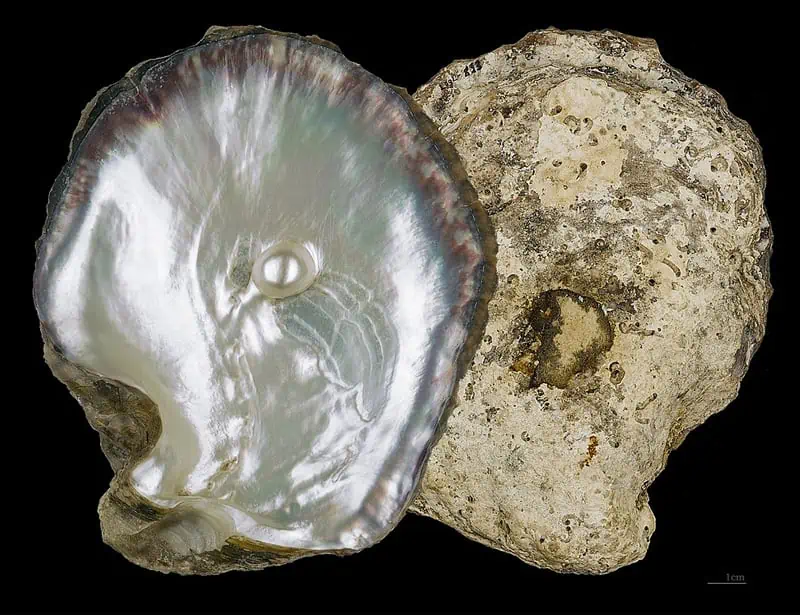
Pearl oysters, a term encompassing various marine mollusk species, are famed producers of lustrous pearls.
The process starts when an irritant enters its shell, such as an invading worm or a bead placed by a pearl farmer. They react by secreting nacre, a mix of amino acids and calcium carbonate, encapsulating the irritant to form a pearl.
Each type creates pearls of distinct sizes and colors, shaped by the size of the producing species and the naturally occurring nacre color.
For example, the black-lip oyster is responsible for the striking obsidian allure of Tahitian pearls. Meanwhile, the Akoya oyster species exert their efforts to yield pearls with neutral colors and green or pink overtones.
These mollusks attach themselves to rocky or gravelly seabeds in both saltwater and freshwater habitats. They also reside in controlled settings like pearl farms.
2. Giant Clam (Tridacna gigas)
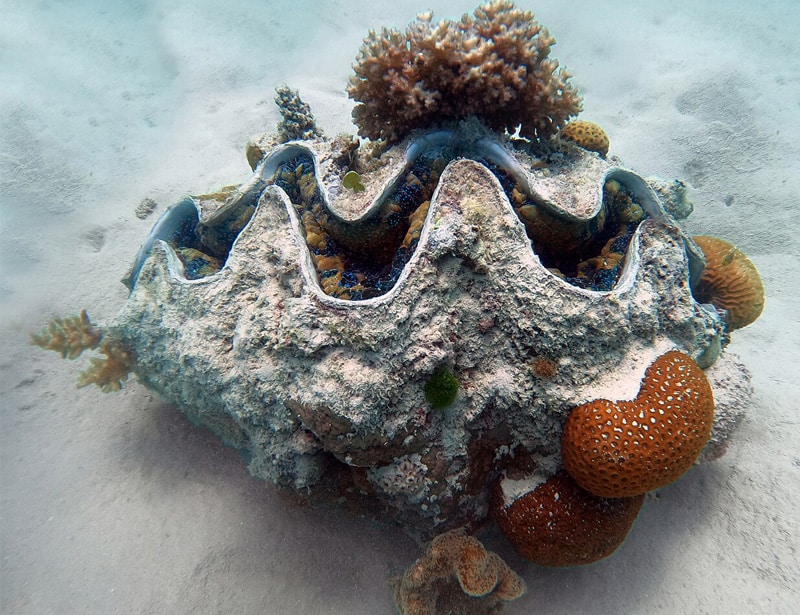
Giant clams, standing as the largest bivalve molluscs, make their homes in the coral reefs in the Tropical Indo-Pacific region.
The record holder for size was over 4.5 feet long. Discovered in Indonesia in the early 19th century, its estimated weight was around 550 pounds when alive3.
In terms of behavior, these marine mollusks are stationary. They respond to disturbance by retracting their vibrant mantle tissue and closing their shells.
Like most bivalves, they are filter feeders. However, the zooxanthellae, a unicellular algae living symbiotically within the clam, provide most of its nourishment.
Without the ability to move, these hermaphrodites release sperm and eggs into the water, allowing nature to take its course.
3. Fan Mussel (Pinna nobilis)
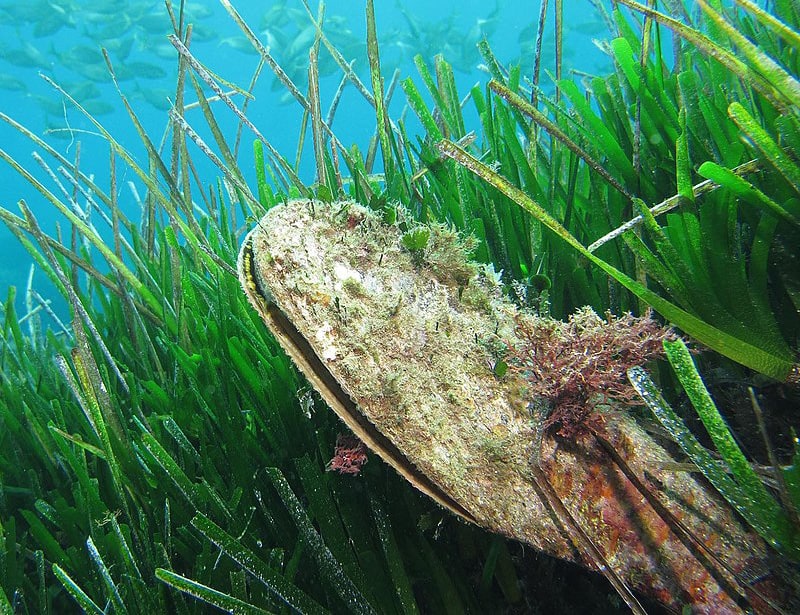
The Fan Mussel, also called Pen Shell and endemic to the Mediterranean, resides offshore, nestled in soft-sediment areas. It plays host to symbiotic shrimp, which live inside the shell and offer alerts upon sensing threats1.
A devastating mass mortality event has occurred since 2016, caused by a harmful parasite and bringing about drastic population declines. Previous threats via illegal fishing, habitat loss, and climate change hadn't previously affected numbers so drastically. Because of these threats, the Fan Mussel is now critically endangered, with anticipated continued declines.
4. Scallop (Pectinidae)
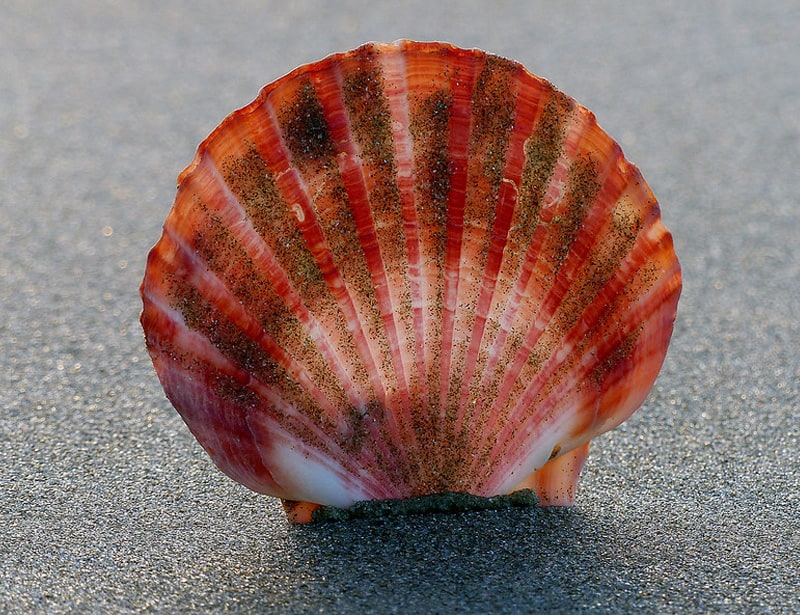
Scallops dwell in every ocean on Earth, a rarity among bivalves. They've evolved the capability of "free-living," swiftly covering short distances and migrating across the seafloor.
These edible bivalves offer culinary delights thanks to their firm white meat and the brightly colored roe.
According to Seafood Watch, scallop farming could be sustainable when done with off-bottom culture methods. Although disease spread to wild species is a potential concern, the low chances of other environmental impacts make this farming method a responsible choice.
Related Read: Most Sustainable Foods For Greener Plates.
5. Zebra Mussel (Dreissena polymorpha)
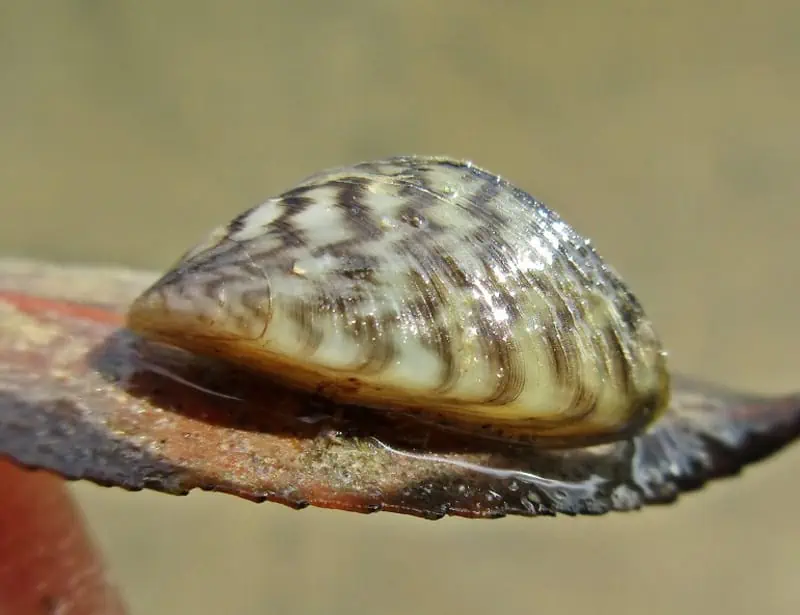
Zebra mussels, originating from Eurasia's fresh waters, have distinctive striped patterns on their shells. Despite their small size, they're known for their significant impact on the habitats they colonize.
Primarily filter feeders, their razor-sharp shells often necessitate protective footwear in the waters they inhabit. Since their invasion of the Great Lakes, these mussels have become a prominent issue, fastening to various submerged surfaces, including boats, docks, and even other mussels.
Hydroelectric companies and municipal water suppliers grappling with blockages from dense populations have found some relief using cupronickel alloy coatings, which zebra mussels struggle to attach.
While they've contributed to the near-extinction of several Great Lakes species, these mussels are effective indicators of environmental pollution, specifically to contaminants representative of water pollution.
6. Garden Snail (Cornu aspersum)
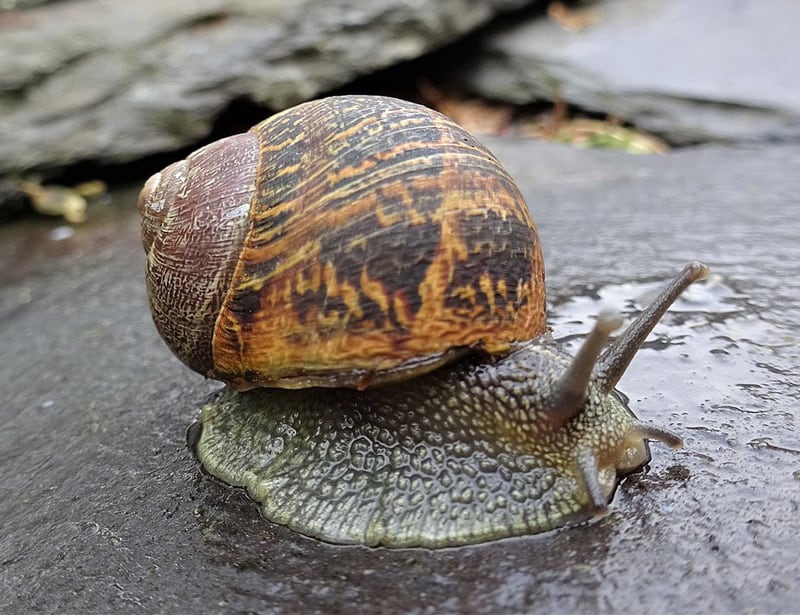
The garden snail is a widely known plant feeder, causing significant damage to crops and ornamentals. Introduced to California in the 1850s for its culinary value, it has since thrived and become a challenging pest.
With a thin, large shell sporting yellow or brown hues accented by fine wrinkles, it adds a distinctive touch to our gardens. Color variations are common, resulting in a visually diverse population with four to five whorls featured on adult shells.
Originating from the Mediterranean, its territorial expanse now includes northwest Africa, Iberia, Asia Minor, Egypt, and even Britain. Courtesy of human influence, it's found globally in places with temperate climates.
Primarily herbivorous, the garden snail isn't a picky eater. It feasts on various plants, from fruit trees and vegetables to rose bushes and garden flowers. It also scavenges on decaying plant matter and crushed fellow snails.
Most importantly, this mollusk forms a vital part of the food chain, eaten by various creatures. Many birds and small mammals benefit from this unassuming trespasser's presence.
Related Read: Types of Snails, Slowest Animals In The World.
7. Golden Apple Snail (Pomacea canaliculata)
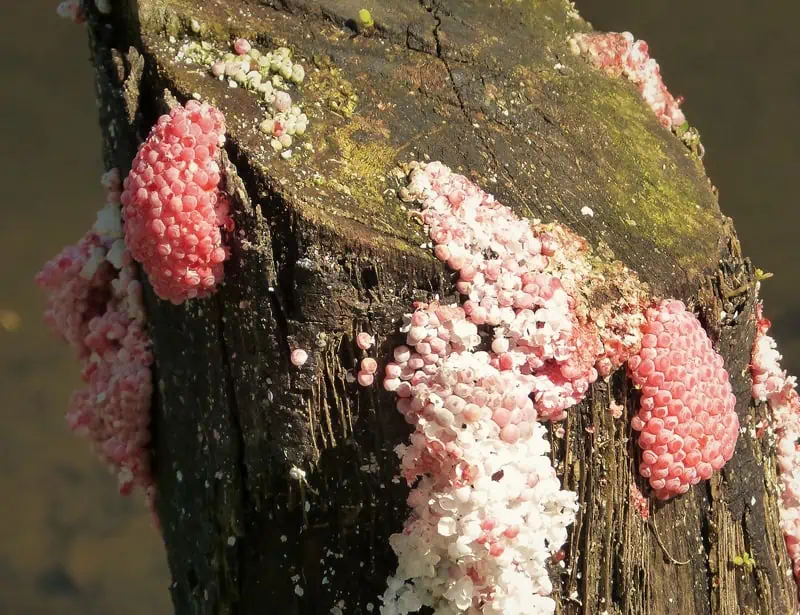
The Golden Apple Snail, hailing from South America, has a distinct, spherical shell. This snail's color patterns are varied, exhibiting bands of brown, black, and yellowish-tan. Albino and gold variances exist, too.
Among the top 100 invasive species, says the IUCN's Global Invasive Species Database, this snail bears significant ecological implications. It feeds with abandon on water plants like lotus, taro, and rice, disrupting native ecosystems and damaging crops, particularly in Southeast Asia and Hawaii.
Furthermore, female Apple Snails lay eggs on emergent vegetation and man-made surfaces. Their eggs transform from vibrant pink or orange to a faded tone before hatching in approximately two weeks. Using this knowledge, water level control in farm fields offers a solution to this persistent pest.
8. Cone Snail (Conidae)
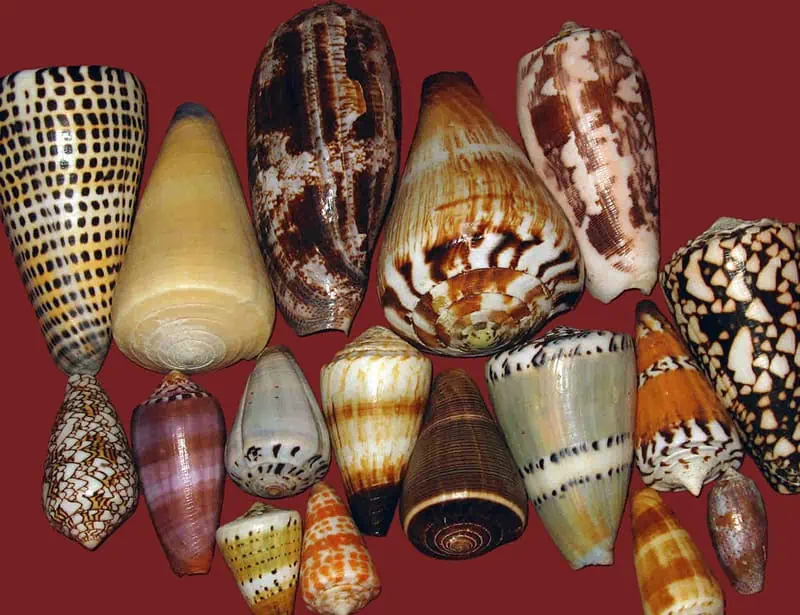
Cone snails are venomous creatures living in tropical oceans worldwide. Their conical shells, decorated with vivid color patterns, can house creatures up to 9 inches long. Appealing to the eye, the shell structure displays a precision seen only in nature’s advanced craftsmanship.
Beneath the stunning exterior lies a lethal arsenal. The Geographical cone, touted as the most venomous among the 500 identified cone snail species, is highly fatal. Its venom, a mix of toxins, is launched from a proboscis thanks to a harpoon-like tooth.
Human contact with this venom calls for immediate medical intervention. Victims might suffer symptoms ranging from swift and intense pain and swelling to delayed responses such as numbness, tingling, and even vomiting. Critical encounters can result in muscle paralysis or fatality.
On the other hand, this venom is a promising resource in pharmaceutical research. With these toxins' swift and selective action on specific body receptors, they've been instrumental in developing drugs for Alzheimer's disease, Parkinson's disease, depression, and epilepsy.
9. Sea Butterfly (Thecosomata)
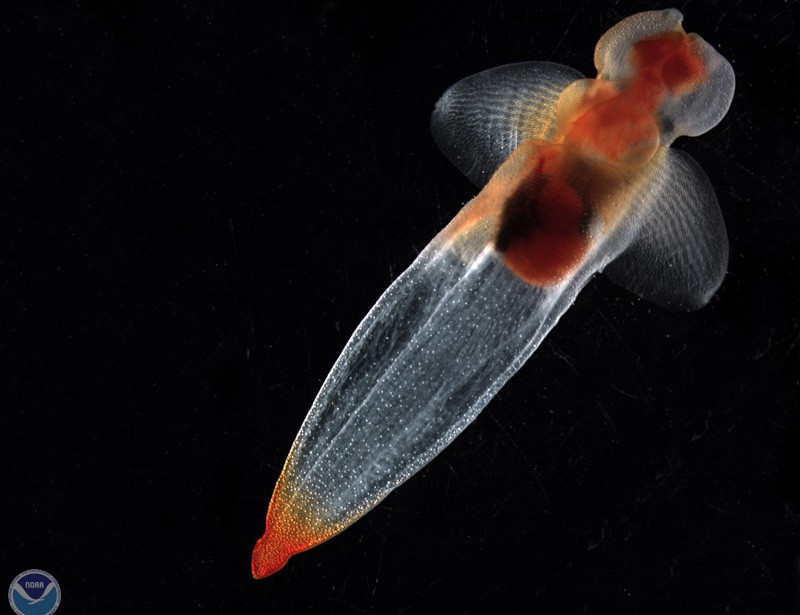
Sea butterflies aren't typical marine gastropods. These free-floating creatures have evolved unique physical features over time.
Often delicate and transparent, their shells are mostly non-existent or greatly diminished in some families. Their snail foot has evolved significantly into wing-like lobes that help them navigate the ocean’s currents.
Its shells are made of calcium with varying shapes, from needle-like to globular. These structures measure less than half an inch, invisible to the naked eye.
Recognized as one of the most populous gastropod species, Sea Butterflies play a crucial role in the oceanic food chain and carbon cycle. Their size masks their immense ecological influence4 beneath our oceans' surface.
10. Blue Sea Slugs (Glaucus atlanticus)
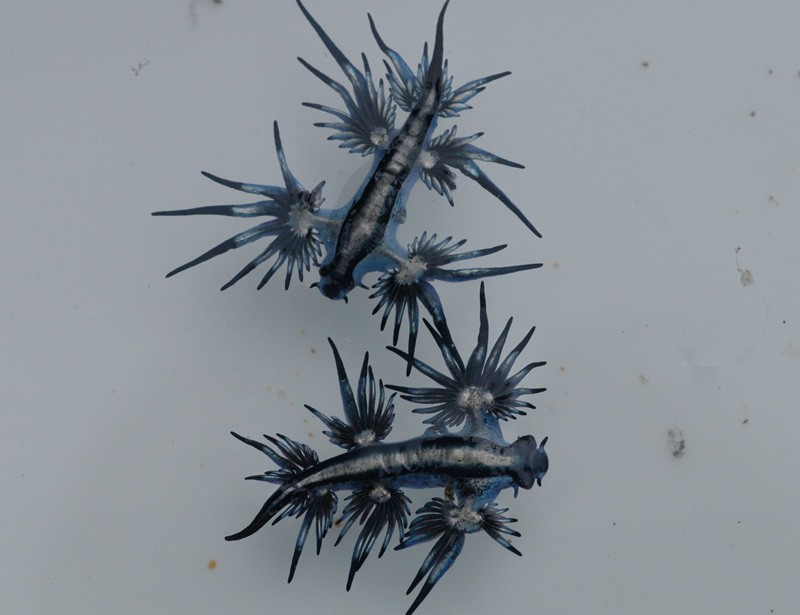
Blue Sea Slugs are shell-less gastropods with the unique ability to float upside down. Surface tension allows them to be guided by wind and ocean currents.
These unique types of mollusks are silvery grey on the top side, while the underbelly carries dark and pale blue hues. Their bodies exhibit dark blue stripes and six finger-like projections called cerata. This form of countershading camouflaged them from would-be attackers.
Despite their average size of 1.2 inches, it's critical to understand these critters are more dangerous than they appear. The tips of their cerata are full of venom from their cnidarian-rich diet. Touching them can induce painful stings, causing symptoms such as nausea, vomiting, and allergic reactions.
11. Tree Snail (Partula)
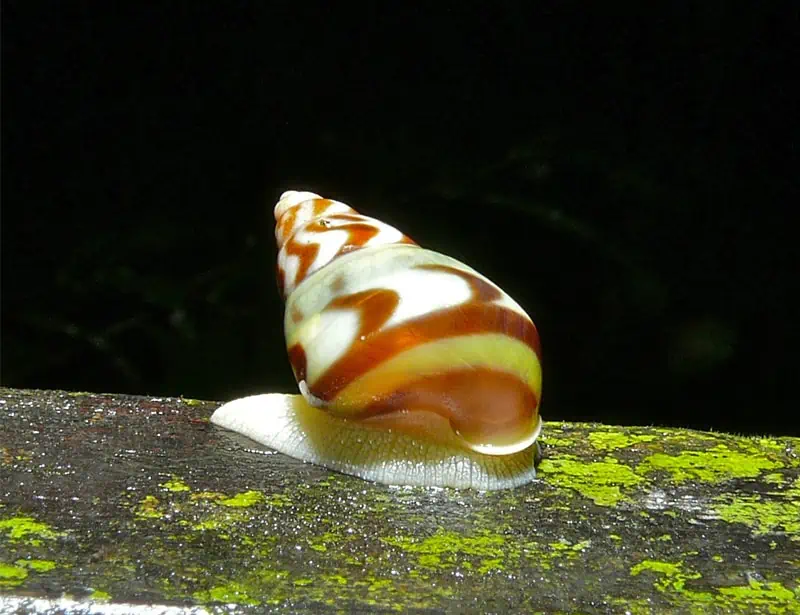
Tree Snails are air-breathing arboreal mollusks. Once threatened by a biological control mishap, these snails narrowly escaped total extinction. The target was the invasive Giant African Land Dnail, but unfortunately, the introduced predator, the Florida Rosy Wolfsnail, preyed on the native Tree Snails instead.
Nearly 64 species of Tree Snails from Tahiti and its islands fell prey to this predator within ten years. Only a dozen species survived. These survivors were protected by quick-reacting scientists before they met a similar fate.
Today, programs work tirelessly to rescue these snails from the edge of extinction. For instance, the Zoological Society of London runs a successful captive-breeding initiative across the UK, France, and the US. Since 2014, they have reintroduced healthy, bred individuals back to Tahiti.
Sadly, the IUCN Red List notes numerous Tree Snail species as critically endangered. As of writing, there are 13 critically endangered, 13 extinct in the wild, and 32 extinct Partula species.
12. Common Octopus (Octopus vulgaris)
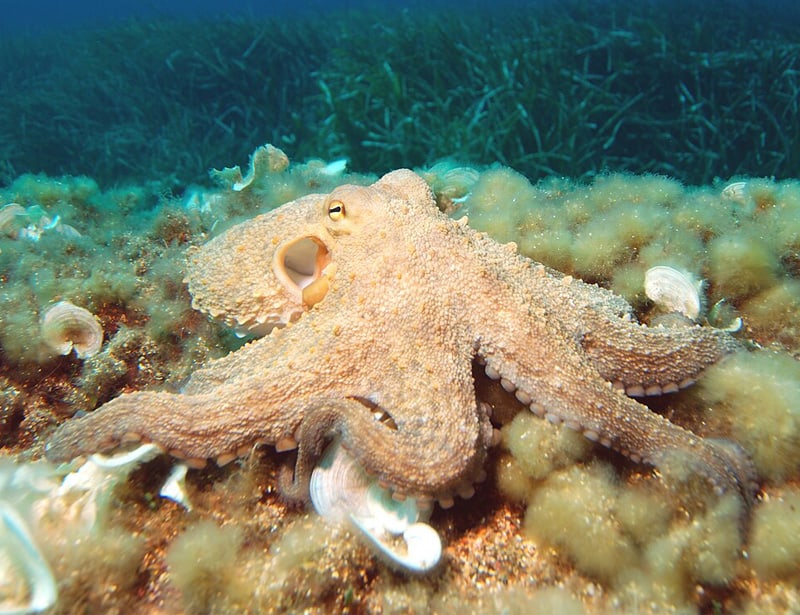
Common octopuses are widespread in tropical, subtropical, and temperate waters worldwide. They are also the most studied octopus species. Notably, they span 1 to 3 feet long, including arms. This is short compared to giant octopuses living under the deep sea.
Aside from their intelligence, their camouflage expertise is extraordinary, adapting color, skin texture, and posture seamlessly according to the substrate. Dive deeper into these types of marine mollusks by checking our list of octopus facts and types of octopus.
13. Blue-ringed Octopus (Hapalochlaena)
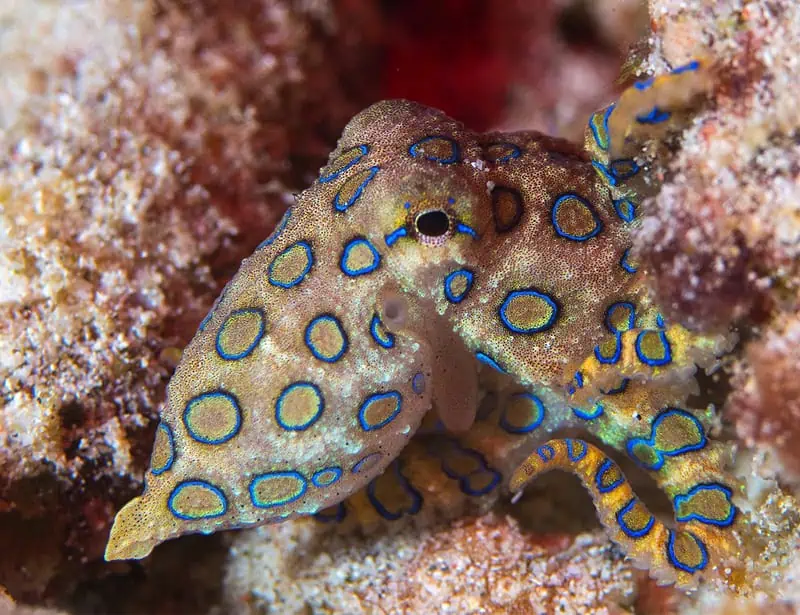
Blue-ringed octopuses are venomous creatures dwelling in Pacific and Indian Ocean tide pools and coral reefs. They favor hiding within crevices, showing skilled camouflage patterns.
When disturbed, they reveal their true vibrant yellow color with eye-catching blue rings, serving as a warning display. One of the four species, the Greater Blue-ringed octopus, glows blue due to light reflectors concentrated in the blue rings5, a phenomenon triggered by muscle movement.
They are small, measuring only 5 to 8 inches, but their toxin, tetrodotoxin, can kill humans swiftly. Their bites are almost unnoticeable until respiratory issues and paralysis set in.
Studies revealed that every octopus carries venom. However, only a few species, like this one, pose a substantial danger to humans.
14. Flamboyant Cuttlefish (Metasepia pfefferi)
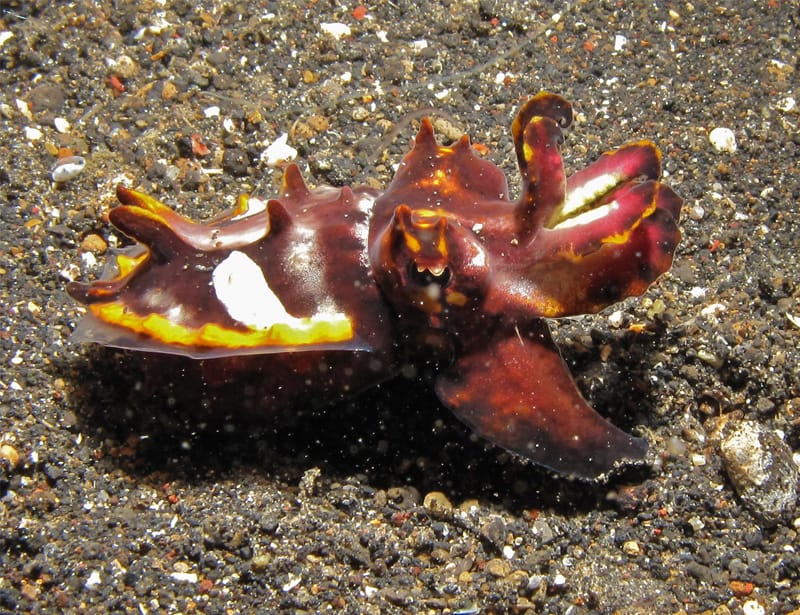
The Flamboyant Cuttlefish resides in the tropical Indo-Pacific oceans. It favors sandy and muddy habitats at depths ranging from 10 to 282 feet.
This small sea creature displays a brown body, highlighted with white, yellow, and rich purple-pink. Due to chromatophores and pigment cells in its skin, it can alter colors. Its mantle is wide, oval-shaped, and arms have four lines of suckers.
A predator at heart, it feeds on crustaceans and fish. Meanwhile, it falls prey to seals, dolphins, and larger fish.
Related Read: Cuttlefish Facts.
15. Chambered Nautilus (Nautilus pompilius)
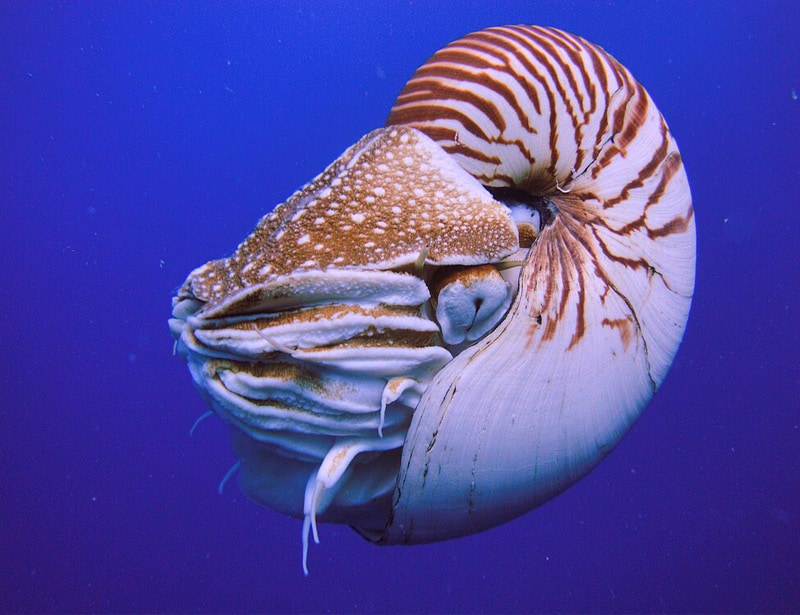
The Chambered Nautilus, also called Pearly Nautilus, dwells in the Indo-Pacific region. Mostly found deep - up to 1640 feet - it ascends at night.
This creature reaches 8 inches in length, sporting a smooth shell with a brown and white pattern. The shell curves above the nautilus, creating around 30 chambers for growth. It resides in the outermost chamber and has a central tube that allows buoyancy control.
Its eyes are rudimentary, lacking lenses and functioning like a pinhole camera. Instead, the nautilus relies on a keen sense of smell to catch fish and crabs, its main prey. Furthermore, it consumes carrion when necessary.
16. Solenogasters (Solenogastres)
Solenogasters are a type of small, shell-less marine mollusks. Unlike typical mollusks, they aren't covered by a shell. Instead, their bodies are protected by calcareous spicules. These can take different arrangements for varying protective functions.
These creatures feed predominantly on jellyfish and sea anemones and comb jellies by sucking their bodily fluids or consuming their tissue.
17. Tryblidiida
The Tryblidiida, a mollusk class survivor, thrives in deep-sea environments. It clings to stones and settles in sediment varieties like silt, sand, and gravel. Unsurprisingly, it's a benthic feeder.
Historically, science labeled Tryblidiida extinct around 375 million years ago. A surprise discovery in Costa Rica in the 1950s changed this belief. Deemed to be a living fossil, it sports repeated organ arrangement, revealing a connection with segmented species like arthropods.
Twenty-nine species of this survivor exist today. Previously conjectured as a link between annelids and mollusks, it now holds a place on the molluscan tree, shedding information on ancestral mollusk conditions6.
18. Jewelled Chiton (Acanthopleura gemmata)
The Jewelled Chiton, a 3-inch long creature, sports an oval body with pronounced dark bands over its brown girdle and eight overlapping plates. It hails from the Indo-Pacific's coastal zone, living on coral reefs, rocks, and cliffs.
Interestingly, this chiton has a homing behavior. A study observed it feeds and returns, instinctively and accurately, to its initial location.
19. West Indian Fuzzy Chiton (Acanthopleura granulata)
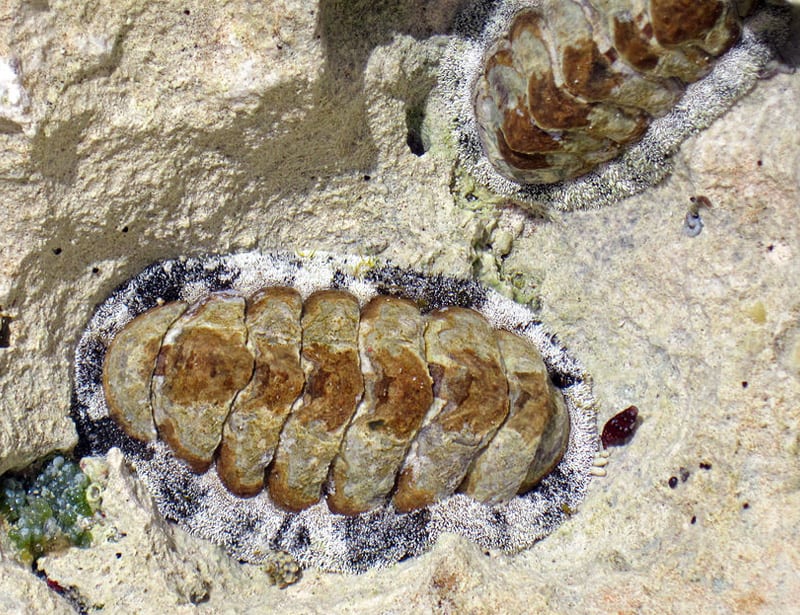
The West Indian Fuzzy Chiton mainly lives from southern Florida to Panama, including Mexico and the West Indies. It thrives on high-intertidal rocks, enduring harsh and variable conditions.
This type of mollusk doesn't grow beyond 2.8 inches in length. Spiky and banded with various hues of black, its girdle encloses the creature's plates, acting as an exterior armor.
Now, the shell of chitons typically comprises eight distinct plates. The West Indian Fuzzy Chiton, though, presents an anomaly. It boasts a fifth valve, split into two symmetrical halves. These halves function independently from the other, separated by a griddle-like tissue.
20. Dentalium
Dentalium feeds on organisms spotted in seafloor sediment. Drawing from the Latin dentist signifying 'tooth,' the name mirrors the mollusk's tooth-like form. Residing within whitish shells, these creatures tunnel through the ocean floor.
Their feeding strategy involves an upward-facing shell while the bulk of the body plunges downward, feasting on microscopic organisms and detritus.
Humans have esteemed these shells for their beauty and utility for generations, spanning decorations, currency, and medicinal purposes.
| 1 |
Hassine, O. K. B., Zouari, S. T., & Rabaoui, L. (2008). Two species of Crustacea (Decapoda) associated with the fan mussel, pinna nobilis Linnaeus, 1758 (Mollusca, Bivalvia). Crustaceana, 81(4), 433–446. |
| 2 |
Rosenberg, G. (2014). A new critical estimate of named Species-Level diversity of the recent mollusca*. American Malacological Bulletin, 32(2), 308. |
| 3 |
McClain, C. R., Balk, M. A., Benfield, M. C., Branch, T. A., Chen, C., Cosgrove, J. A., Dove, A. D. M., Gaskins, L. C., Helm, R. R., Hochberg, F. G., Lee, F. B., Marshall, A. D., McMurray, S. E., Schanche, C., Stone, S. N., & Thaler, A. D. (2015). Sizing ocean giants: patterns of intraspecific size variation in marine megafauna. PeerJ, 3, e715. |
| 4 |
Comeau, S., Gorsky, G., Jeffree, R. A., Teyssié, J., & Gattuso, J. (2009). Impact of ocean acidification on a key Arctic pelagic mollusc (Limacina helicina). Biogeosciences, 6(9), 1877–1882. |
| 5 |
Mäthger, L. M., Bell, G. R. R., Kuzirian, A. M., Allen, J. J., & Hanlon, R. T. (2012). How does the blue-ringed octopus (Hapalochlaena lunulata) flash its blue rings? The Journal of Experimental Biology, 215(21), 3752–3757. |
| 6 |
Lindberg, D. R. (2009). Monoplacophorans and the origin and relationships of mollusks. Evolution: Education and Outreach, 2(2), 191–203. |
Mike is a degree-qualified researcher and writer passionate about increasing global awareness about climate change and encouraging people to act collectively in resolving these issues.
Fact Checked By:
Isabela Sedano, BEng.

